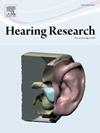基于静息状态EEG-fNIRS的健康老年人言语感知下降的功能特征
IF 2.5
2区 医学
Q1 AUDIOLOGY & SPEECH-LANGUAGE PATHOLOGY
引用次数: 0
摘要
老年人经常在嘈杂的环境中与语言感知作斗争,这一挑战受到与年龄相关的大脑功能变化的影响。静息状态下的大脑活动已经成为了解与衰老相关的功能连接变化的关键研究领域。本文采用多模态方法,结合脑电图(EEG)和功能近红外光谱(fNIRS),研究衰老对静息状态听觉网络的影响。此外,我们在不同的信噪比(SNR)条件下评估了三个年龄组的语音感知-青年组(YG),中年组(MG)和老年人组(OG) -在安静(SIQ),中等噪音(SNR = 5 dB)和高噪音(SNR = - 5 dB)下的语音感知。结果表明,衰老与大脑中负责语言处理和认知控制的关键区域的功能连接性增强有关,这些区域包括背外侧前额叶皮层、布罗卡区、韦尼克区,以及初级听觉皮层和听觉关联皮层。然而,尽管这种连接性增强了,关键的网络特性——比如小世界、局部效率和节点效率——显示出下降,尤其是在与语言相关的区域,比如左颞上回。脑电图微状态分析进一步强调了随着年龄增长大脑动力学的转变,显示了从微观状态C到微观状态d的转变。这种转变表明对执行功能的补偿性依赖,可能反映了一种适应机制,以抵消与年龄相关的听觉处理效率下降。值得注意的是,在嘈杂环境中,更高的小世界和局部效率与更好的语音识别相关,而特定的微状态特征与更好的语音感知性能相关。这些发现表明,衰老会改变大脑网络动态,导致支持听觉处理的代偿性神经适应。本研究通过脑电和近红外光谱的结合,全面分析了语音感知和认知控制的年龄相关变化的神经机制。该结果强调了功能连接和网络效率在维持老年人言语理解中的重要性,为年龄相关听觉衰退的神经特征提供了探索性证据,为未来的干预研究提供了信息。本文章由计算机程序翻译,如有差异,请以英文原文为准。
Functional characteristics of speech perception decline in healthy aging based on resting-state EEG-fNIRS
Older adults frequently struggle with speech perception in noisy environments, a challenge influenced by age-related changes in brain function. Resting-state brain activity has emerged as a crucial area of research for understanding alterations in functional connectivity associated with aging. We herein used a multimodal approach, integrating electroencephalography (EEG) and functional near-infrared spectroscopy (fNIRS), to examine how aging affects the resting-state auditory network. Additionally, we assessed speech perception across three age groups—youth group (YG), middle-aged group (MG), and older group (OG)—under varying signal-to-noise ratio (SNR) conditions: speech in quiet (SIQ), moderate noise (SNR = 5 dB), and high noise (SNR = −5 dB). The results indicate that aging is linked to heightened functional connectivity in key brain regions responsible for speech processing and cognitive control, including the dorsolateral prefrontal cortex, Broca’s area, Wernicke’s area, and both the primary auditory cortex and auditory association cortices. However, despite this heightened connectivity, critical network properties—such as small-worldness, local efficiency, and nodal efficiency—show a decline, particularly in speech-related regions such as the left superior temporal gyrus. EEG microstate analysis further highlights a shift in brain dynamics with aging, demonstrating a transition from microstate C to microstate D. This shift suggests a compensatory reliance on executive functions, likely reflecting an adaptive mechanism to counteract age-related declines in auditory processing efficiency. Notably, higher small-worldness and local efficiency correlate with better speech recognition in noisy environments, while specific microstate features are associated with improved speech perception performance. These findings indicate that aging alters brain network dynamics, leading to compensatory neural adaptations that support auditory processing. By integrating EEG and fNIRS, this study provides a comprehensive analysis of the neural mechanisms underlying age-related changes in speech perception and cognitive control. The results underscore the importance of functional connectivity and network efficiency in maintaining speech comprehension in older adults, provide exploratory evidence on neural features underlying age-related auditory decline, which may inform future intervention research.
求助全文
通过发布文献求助,成功后即可免费获取论文全文。
去求助
来源期刊

Hearing Research
医学-耳鼻喉科学
CiteScore
5.30
自引率
14.30%
发文量
163
审稿时长
75 days
期刊介绍:
The aim of the journal is to provide a forum for papers concerned with basic peripheral and central auditory mechanisms. Emphasis is on experimental and clinical studies, but theoretical and methodological papers will also be considered. The journal publishes original research papers, review and mini- review articles, rapid communications, method/protocol and perspective articles.
Papers submitted should deal with auditory anatomy, physiology, psychophysics, imaging, modeling and behavioural studies in animals and humans, as well as hearing aids and cochlear implants. Papers dealing with the vestibular system are also considered for publication. Papers on comparative aspects of hearing and on effects of drugs and environmental contaminants on hearing function will also be considered. Clinical papers will be accepted when they contribute to the understanding of normal and pathological hearing functions.
 求助内容:
求助内容: 应助结果提醒方式:
应助结果提醒方式:


